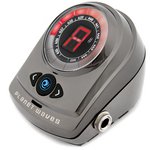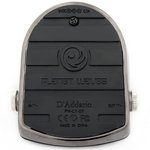The True Strobe Tuner
from Planet Waves
 Most tuners work about the same, and tune fairly well, but the True Strobe tuner from Planet Waves (PW-CT-07) is great when you absolutely, positively have to be dead-on accurate.
Most tuners work about the same, and tune fairly well, but the True Strobe tuner from Planet Waves (PW-CT-07) is great when you absolutely, positively have to be dead-on accurate.
The bulk of the tuners on the market, and certainly most under $100, are accurate to about +/- 3 cents. The True Strobe tuner is accurate to +/- 0.1 cent, that's fifteen-times more accurate!
What's a "cent" and why do you care?
Tuning accuracy is measured in units called cents. Each semitone (one fret on a guitar) is divided into 100 cents.
If a tuner is accurate to within +/- 3 cents (as most are), that's the same as +/- 3%. If you tune one string to -3%, and the next string to +3%, that's a total of 6% out-of-tune. Is that enough for you to hear? It depends on how good your hearing is. Most people can hear a tone difference of 5%. Is a difference of 6% good enough for recording or for filing down frets to correct intonation problems? Absolutely not.
Using the True Strobe Tuner
 The True Strobe is powered by one 9-volt battery, or by an AC Adapter (the battery is included, an AC adapter is not). Changing the battery requires a phillips-head screwdriver. Turn the unit over to remove one screw holding the rubber-padded base plate in place (see photo at right). When your battery power is low, an "L" will flash in the center display.
The True Strobe is powered by one 9-volt battery, or by an AC Adapter (the battery is included, an AC adapter is not). Changing the battery requires a phillips-head screwdriver. Turn the unit over to remove one screw holding the rubber-padded base plate in place (see photo at right). When your battery power is low, an "L" will flash in the center display.
The tuner is solidly made of metal, with a durable rubber foot, and is heavy enough to stay right where you put it.
There are two 1/4" connectors on the tuner: one on each side. One is an input, the other is an output, making it easy to insert it between your instrument and your amplifier, sound card, or PA system.
Most users will probably plug directly into the 1/4" input-jack. If you don't have a cable handy, or don't wish to use one, the tuner automatically switches to the built-in microphone.
Turn the tuner on by pressing the circular on/off switch at the front/bottom of the unit and holding it until a line in the center of the display flashes. If you release it too quickly, the tuner immediately turns off.
The tuner automatically calibrates itself, then indicates its readiness with a blinking LED in the center of the display.
When you pluck a string on your guitar, the tuner responds by displaying the nearest note name and indicating how close you are to "in-tune" with a circle of lights. If the lights are moving clockwise, the note is too sharp. Counter-clockwise movement is too flat. The faster the lights move, the more out of tune your instrument is. When the lights stop moving, you are in tune.
Though most catalogs show the True Tone tuner with blue lights, mine had red. According to Planet Waves, this is due to a shortage of blue LED's. Presumably, as blue LEDs become available in sufficient quantity, they'll begin shipping with them. Color did not matter to me, but some may find one or the other more to their liking.
The Good and the Bad...
The True Strobe is best suited for use as a desktop tuner, and would be right at home in the studio or a luthier's shop. When you consider its accuracy (about 15 times more accurate then a standard tuner) it's a great tool for such applications. If your band-mates demand absolute accuracy, it may also be for you.
On stage, however, it's not as natural a fit. First, though it does allow pass-through tuning, there is no muting feature. Unless you have another method to bypass your signal, everyone in the house will hear you tune up. Not good. Also, though you could rest it on the floor, it should be on a shelf or table to press down on the power button.
With an active acoustic-electric the True Strobe tuner was a pleasure to use - probably the best I've ever tried. Response was quick, the LED's were smooth, it was very easy to judge how fast I should turn my tuning keys to quickly get in tune. It was also rock steady. (I don't know about you, but I get very frustrated by tuners that indicate in-tune, then drift up and down. There was none of this with the True Strobe.)
Interestingly, with a passive electric guitar response was occasionally poor, as though no signal was reaching the tuner. One time this 'no response' bug bit me while on stage. It held up rehearsal and did not please my band-mates. I have not figured out the trick to ensure this does not happen again, but I now keep my volume up to minimize the problem.
Bottom Line
If you are a luthier, a guitar tech for a demanding client, or if you're going into the studio to record, you simply can't tolerate tuning errors. For these applications, the Planet Waves True Strobe tuner is practically a requirement.


